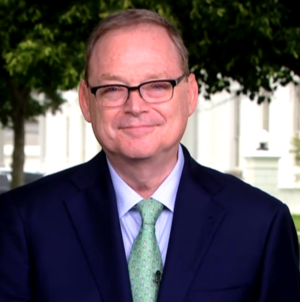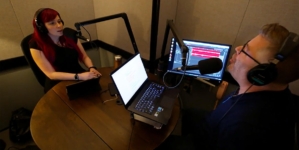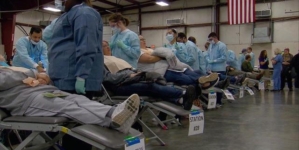-
Israel Intercepts Gaza-Bound Ship With Greta Thunberg on Board - 20 mins ago
-
Internet Can’t Cope With What Vet Does for Patients Who ‘Need an Exorcism’ - 23 mins ago
-
Astros vs. Guardians Highlights | MLB on FOX - 32 mins ago
-
Browns Insider Reveals Major Update Regarding Dillon Gabriel - about 1 hour ago
-
Prince William says ocean conservation is a challenge like no other ahead of U.N. summit - about 1 hour ago
-
Diamondbacks vs. Reds Highlights | MLB on FOX - about 1 hour ago
-
Underwater jetpack backpack lets you explore ocean depths - 2 hours ago
-
Meghan Markle’s ‘Baby Mama’ Dance Compared to Princess Kate - 2 hours ago
-
Israel reveals tunnel under Gaza hospital where it says body of Hamas military chief was found - 2 hours ago
-
Padres vs. Brewers Highlights | MLB on FOX - 2 hours ago
Most Americans can’t afford a $1,000 emergency expense, report finds
Whether it’s a busted refrigerator, car trouble or medical issues, unexpected costs are a part of life. But even such routine curveballs often spell serious financial trouble for many Americans.
That’s according to a new Bankrate report that surveyed more than 1,000 U.S. adults about their ability to handle a surprise bill. Despite the country’s current low unemployment rate, the annual study found that 59% of Americans in 2025 don’t have enough savings to cover an unexpected $1,000 emergency expense.
“We are essentially a paycheck-to-paycheck nation,” Bankrate Senior Economic Analyst Mark Hamrick said in a statement. “Fewer Americans have the equivalent of a financial safety net to cover inevitable unexpected expenses, despite low unemployment and steady growth. This is one of the consequences of elevated prices stemming from inflation, the impacts of which are still being felt.”
A key issue in the 2024 presidential election, inflation and the rising cost of everyday items continues to impact Americans. Grocery inflation during the height of the coronavirus epidemic reached a peak of 13.5% in 2022, while the overall rate of inflation for all products and services topped out at 9.1%.
Although inflation has cooled to an annual rate of 2.9% as of December, prices for food, shelter and many other items remain elevated. Consumers also have found that many common products, from snacks to paper towels, have gotten smaller, a retailing known known as “shrinkflation aimed at cutting a manufacturer’s costs.
In his Jan. 20 inaugural speech, President Trump said he would direct his cabinet “to marshal the vast powers at their disposal to defeat what was record inflation and rapidly bring down costs and prices.”
Whether the Trump administration can engineer such a feat remains to be seen, while polls suggest that many Americans are skeptical that prices will return to earth. Economists also warn that Mr. Trump’s policies, which could include steep new tariffs on U.S. imports and the deportation millions of undocumented immigrants, could prove inflationary.
Younger Americans worry most
To be sure, the meteoric rise in the cost of food, housing and health care over the past several years has made it hard for many households to make ends meet, let alone save money. Bankrate’s survey shows that 73% of Americans said they’re saving less for unexpected expenses, compared with 68% in 2024.
“Though inflation is no longer rising as quickly as it did in recent years, more people this year feel the economy has affected their savings,” according to the Bankrate report.
Younger Americans tend to have the strongest concerns about their savings. A whopping 80% of Gen Zers worry about being able to cover immediate expenses if they were to suddenly lose their primary source of income, compared with 72% for Millennials and Gen Xers. Some 58% of Baby Boomers say they regularly fret about having enough money put away, a particular concern given that many are already retired.
Borrower nation
Only 41% of Americans said they would be able to tap their savings to cover an unexpected $1,000 expense, according to Bankrate’s report. That’s down 3% from 2024 and the lowest the percentage since 2021 (39%)
Another 25% said they would use a credit card to pay for a $1,000 bill, 13% said they would turn to a family member for the money and 5% said they would take out a personal loan. In total, about 43% of respondents told Bankrate they would have to borrow money to pay for an emergency expense of $1,000.
That’s a concern given consumers collectively owe a record $1.14 trillion in credit card debt, figures from the Federal Reserve Bank of New York show. Meanwhile, credit card rates continue to soar, hovering round 24%.
“The cost of living continues to rise, prompting more individuals and households to turn to credit cards when in a bind,” Hamrick said. “They are a terrific tool when used wisely and effectively. But with interest rates still high, we need to avoid a deepening debt burden which could make it more challenging to save.”
Another 13% of Americans said they would pay for a surprise $1,000 debt by curbing their spending, On a positive note, while 36% of adults said their credit card debt exceeded what they had in emergency savings, Bankrate found that more than half of survey respondents, at 55%, had more emergency savings in 2024 than credit card debt. That’s the highest percentage since 2018.
Asked how much they have in emergency savings, 28% of respondents said they had enough to cover six months of expenses; 16% said they had enough to cover three to five months; 29% had enough to cover less than three months’ worth of bills; and 27% said they had no emergency savings at all.
Tips for saving now
For people who consider themselves among the roughly one-third of Americans who want to reduce their debt and boost their emergency savings in 2025, Bankrate offers three tips:
- Calculate how much you need to save. As a general target, experts recommend saving three to six months’ worth of expenses in case of emergencies. To figure out how much to put away, add the total amount you spend each month on food, housing, gas and other bills. So if your monthly bills amount to $2,000 a month, you’ll need $6,000 in savings to stay afloat in case of an emergency, such as a job loss.
-
Open a savings account just for emergencies. Opening an online savings account, money market account, money market mutual fund or a separate savings account with your existing bank or credit union can help you save for unexpected emergencies.
-
Make a budget — and stick to it. Establish guardrails around your spending habits by putting a budget in place that allows you to start saving or stash more money away. Keep it as a reminder to help you develop good habits. If you’re new to saving, Bankrate Chief Financial Analyst Greg McBride recommends setting up an automatic transfer of money from your checking account into a dedicated savings account to help you get started.
“Automating the savings is the key to making it happen,” McBride said in the report.
Source link































